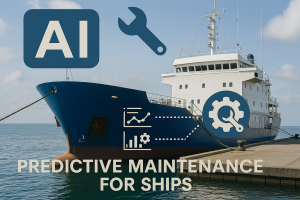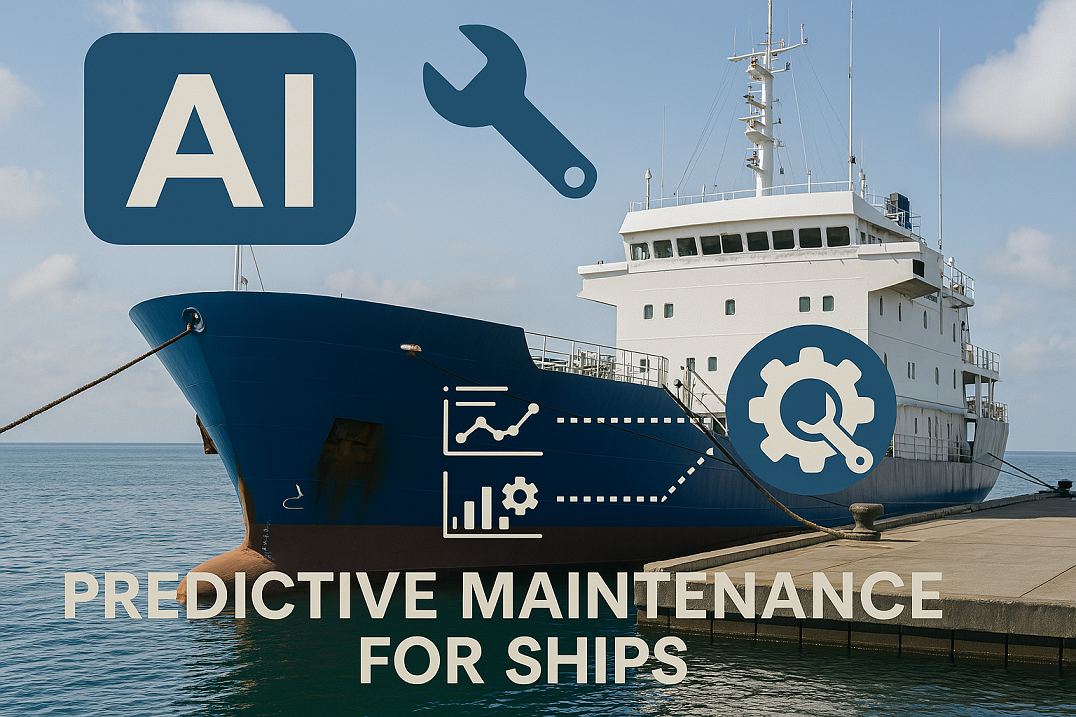Explore how AI predictive maintenance for ships is transforming maritime operations by detecting engine issues before failure and saving millions in repair costs. Learn how sensors + AI ensure safer, smarter, and more efficient voyages.

What if your ship could warn you of an engine failure days before it happens?
With rising operational costs and strict regulatory demands, maritime companies are turning to AI predictive maintenance for ships to boost reliability, prevent breakdowns, and reduce costly repairs. Powered by smart sensors, machine learning, and real-time diagnostics, AI is helping ship officers and engineers shift from reactive to proactive maintenance.
This article offers a deep dive into:
-
How AI detects engine failures before they happen
-
The role of sensors in real-time ship monitoring
-
How predictive maintenance saves millions for fleets
Tailored for maritime students, cadets, engineers, shipping companies, and professionals, this guide highlights how AI is reshaping ship maintenance practices worldwide.
What Is AI Predictive Maintenance on Ships?
AI predictive maintenance uses real-time data, machine learning, and condition-based monitoring to forecast equipment failures before they occur.
Key Components:
-
Smart Sensors: Collect data on temperature, vibration, oil quality, pressure, RPMs
-
AI Algorithms: Analyze trends and detect early warning signs of failure
-
Predictive Models: Estimate time-to-failure and recommend maintenance actions
⚙️ Keyword Highlight: “AI predictive maintenance ships” is gaining traction in smart shipping, especially within engine room automation and Condition-Based Maintenance (CBM).
🚢 How AI Detects Engine Failures Before They Happen
Traditionally, marine engineers relied on manual checks and routine schedules to maintain ship machinery. But these methods often miss subtle patterns that precede failure.
AI-Powered Detection Process:
-
Sensor Data Collection: Vibration, oil debris, engine noise, heat levels
-
Data Analysis: AI compares new data with historical trends
-
Anomaly Detection: Identifies unusual patterns (e.g., bearing misalignment, turbocharger wear)
-
Early Warnings: Notifies crew of critical thresholds being approached
-
Decision Support: Suggests corrective actions or part replacements
🧠 Example: An AI system detected micro-vibrations in a ship’s diesel engine shaft—predicting a failure 3 weeks before any symptoms were visible to crew or logs.
💡 Sensors + AI: Saving Millions in Ship Repair Costs
Unplanned maintenance and engine failure at sea can cost hundreds of thousands of dollars—not to mention voyage delays, off-hire penalties, and environmental risks.
Benefits of Predictive AI Maintenance:
-
Reduces unplanned downtime
-
Extends machinery lifespan
-
Optimizes spare parts inventory
-
Improves crew safety
-
Minimizes fuel overuse and emissions
Case Study: Wärtsilä’s AI Engine Diagnostics
-
Integrated predictive analytics across a fleet of cargo vessels
-
Reduced unplanned maintenance by over 40%
-
Saved nearly $1.5 million in repairs and downtime over one year
🔧 Maritime Insight: Many shipping companies now mandate AI-CBM systems in technical management strategies, particularly for high-value vessels like LNG tankers and cruise ships.
📡 How It Works: AI Predictive Maintenance System Components
| Component | Function |
|---|---|
| IoT Sensors | Measure vibration, temperature, fluid levels, RPM, and pressure |
| Edge Devices | Pre-process data locally before sending to the cloud |
| AI Analytics Engine | Uses historical + real-time data to detect anomalies and predict component life cycles |
| Crew Dashboards | Provide alerts, visual reports, and maintenance scheduling tools |
Supported Equipment:
-
Main Engines
-
Auxiliary Generators
-
Air Compressors
-
Pumps and Piping Systems
-
Propulsion Shafts and Gearboxes
🔍 AI Predictive Maintenance vs Traditional Ship Maintenance
| Aspect | Traditional Maintenance | AI Predictive Maintenance |
|---|---|---|
| Method | Time-based or reactive | Data-driven and proactive |
| Inspection Frequency | Fixed schedule | Based on real-time condition |
| Failure Risk | High for unexpected faults | Significantly reduced |
| Crew Involvement | Manual checks and logs | Automated alerts and decision support |
| Cost Efficiency | High long-term costs | Lower lifecycle and repair costs |
⚓ Takeaway: Predictive maintenance not only enhances machinery performance but also aligns with IMO’s decarbonization goals by reducing fuel waste due to poor engine performance.
FAQs: People Also Ask
How does AI detect problems in ship engines?
AI detects early-stage problems by analyzing real-time sensor data (e.g., heat, vibrations, noise) and identifying patterns that correlate with known failure modes.
What sensors are used for predictive maintenance?
Sensors monitor vibration, temperature, lubricant quality, pressure, and electrical load—key indicators of engine and machinery health.
Is predictive maintenance better than preventive maintenance?
Yes. Predictive maintenance is more cost-effective, less disruptive, and tailored to real-world conditions, unlike fixed-interval preventive maintenance.
Which companies offer AI predictive maintenance for ships?
-
Wärtsilä (Expert Insight)
-
ABB Marine Digital Services
-
Rolls-Royce (Health Management System)
-
DNV Veracity Platform
🔮 Latest Trends & Future Outlook
| Emerging Trend | Impact on Ship Maintenance |
|---|---|
| AI + Digital Twins | Virtual replica of ship components to simulate wear and tear |
| Cloud-Based Maintenance Logs | Fleet-wide sharing of performance insights |
| Hybrid AI Systems (FMU + ML) | Combines physics-based models with AI for higher accuracy |
| Autonomous Maintenance Suggestions | Recommends next steps without manual input |
📈 Forecast: According to Lloyd’s Register, 70% of new ships delivered by 2030 will feature AI-based maintenance platforms.
Conclusion: Smarter Ships, Safer Seas
As the maritime world becomes increasingly digitized, AI predictive maintenance for ships is no longer a luxury—it’s a necessity. From detecting hidden faults to optimizing maintenance costs, AI is empowering engineers, cadets, and companies to move toward safer, more efficient, and environmentally sustainable operations.
🚢 Call to Action: Whether you’re maintaining a fishing trawler or managing a cargo fleet, now is the time to explore and implement AI-powered maintenance systems—the smart way to sail into the future.
References & Further Reading
Suggested Links from MaritimeEducation:
Ship Hull Maintenance and Cleaning: Cutting Costs and Emissions
Engine Room Safety and Maintenance: Ensuring Reliability at Sea


Very useful information. I would like to have a copy of these articles.